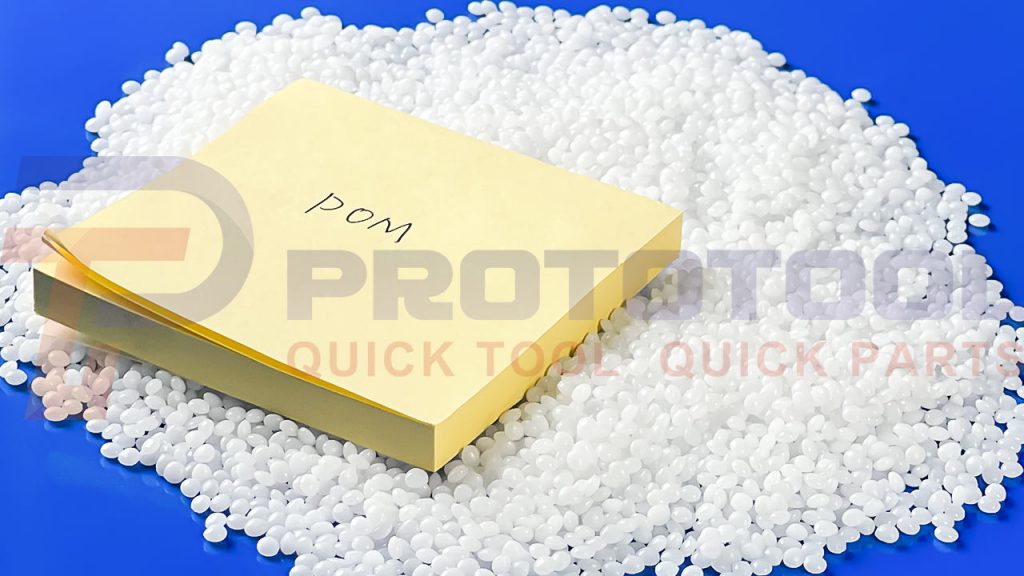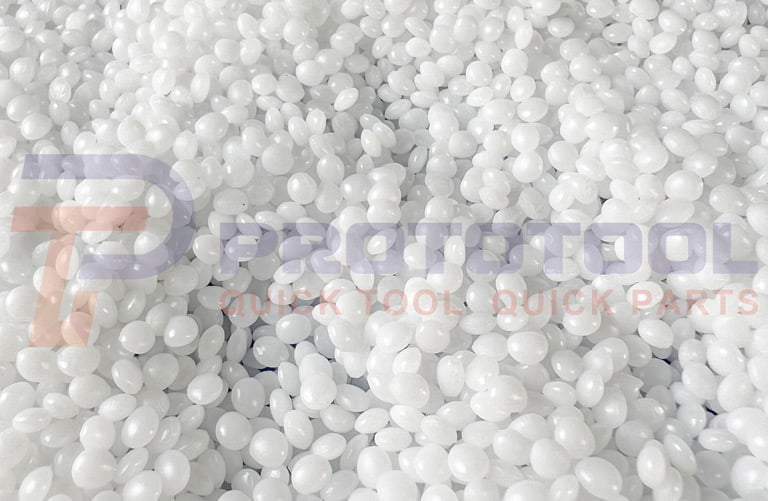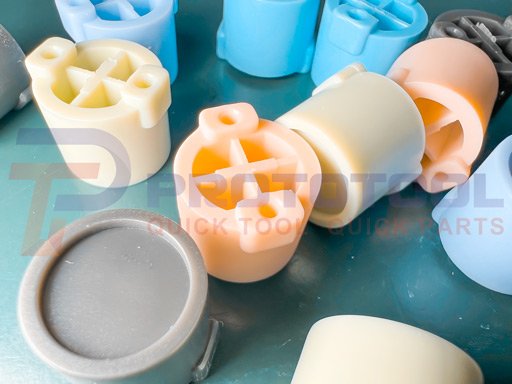POM, a short name for polyoxymethylene material, more commonly known as acetal, is widely used as an injection molding and machining material. It is an engineering-grade, semi-crystalline thermoplastic with excellent dimensional stability, high strength, a wide operating temperature range, and low friction. Numerous benefits of POM plastic make it great for manufacturing highly long-lasting and accurate parts.
POM plastic is used frequently in CNC Machining, Injection Molding, and 3D Printing because of its durability and toughness. It’s challenging, which is good when dealing with a part requiring careful attention to detail. It holds up well in extremely hot environments. It has good wear resistance and is suitable for additive manufacturing. In any of its many grades, POM also has many other desirable qualities.
Keep reading to discover why POM plastic is a good option for your next project.
POM is an excellent alternative for metal because of its superior resistance to wear, high tensile strength, minimal friction, and increased warp resistance. Furthermore, it is generally tough and resilient, making it suitable for rigorous uses.

Beside, POM is an excellent metal substitute due to its superior density, low moisture absorption, and resistance to hydrocarbons, solvents, and neutral chemicals. This article describes the various benefits of POM plastic.
Properties of POM plastic
· Mechanical
Like many other materials, POM softens and becomes less sturdy when heated. The tensile strength of POM is just 10,000 psi at room temperature. Yet, it has a stiff flexural modulus of 410,000 psi with no discernible yield point. Moreover, it has excellent fatigue resistance and can almost indefinitely withstand cyclic compressive and tensile loads of 5,000 psi.
POM is very resistant to distortion and permanent dents, making it ideal for use in impact applications. As the resin’s molecular weight grows, its durability also improves.
· Chemical
POM has exceptional resistance to organic solvents. In particular, below 160 degrees Fahrenheit, nearly no common solvents can dissolve POM plastic. On the other hand, POM should be avoided in situations with strong acids, bases, or oxidizing agents.
POM is suitable for many underground uses because it is impervious to rot, rust, and damage caused by insects and fungi. It also resists fading and stains when kept at temperatures below 320 degrees Fahrenheit.
· Thermal
POM is not brittle at low temperatures since it does not depend on plasticizing to produce its toughness. There is only a 20% decrease in impact resistance from room temperature to -40 degrees Fahrenheit. POM has a flexural modulus of 180,00 and a tensile strength of 2,000 psi. It maintains a high level of strength at temperatures as high as 200 degrees Fahrenheit. POM has a maximum service temperature of 180 degrees Fahrenheit in air and 150 degrees Fahrenheit in water. It can withstand brief temperature spikes of up to 250 degrees Fahrenheit.
POM is a great dielectric material for electrical applications because its dissipation factors and dielectric constants are very small throughout a broad temperature and frequency range. In addition, its dielectric properties are preserved even when submerged in water, which is useful in humid environments.

Benefits of POM Plastic
· Durable
POM’s versatility and durability make it an attractive material for commercial, mechanical, automotive, aerospace, energy, food service, healthcare, and consumer products. It is a highly malleable substance that may be used to fulfill an unusually broad range of needs.
· Reliable in Wet Environments
POM is an excellent choice for pump and valve components due to its reliability in damp or wet environments. For the same reasons, it’s also suitable for kitchen faucets and other water-using equipment. Bearings, bushings, gears, fittings, sliding and guiding parts, rollers, conveyor systems, scraper blades, and other electrical insulator components may be manufactured with POM in the automotive, mechanical, and industrial sectors. Because of its high resistance to impact is used in various aviation parts, including safety restraints, door systems, and zip fasteners.
· Medical Applications
POM is a great material for various medical applications, including valves, pumps, inhalers, syringes, pen injectors, diagnostics, wound care, medical gas and fluid management, medical instruments, prostheses, and implants.
· Versatile Plastic
POM is a versatile plastic that can be used to make things like sports gear, eyeglass accessories, and even food storage containers, all of which need a high level of strength and durability.
POM Plastic as a Metal Alternative
The advantages of POM plastic in your components and projects have been well shown. There are, however, cases when solving the equation becomes more challenging. With our help, you may determine whether POM plastic is a viable metal alternative for your current material.
POM Plastic vs. Metals
Considering the benefit-to-cost ratio when deciding between POM plastics and metals is essential. Therefore, how can you even begin to assess?
Consider a Simple Material Change in the Component’s Design
Let’s pretend you’ve developed a prototype using a metal alloy. As a metal alternative, you may try using a polymer with the same physical and geometric qualities as the metal. If the metal design is not ideal, you might be able to make major improvements by switching to polymers. For the best trade-off between weight and price, go with the plastic part that is easier to produce at a lower cost.
Consider a Redesign That Embraces the Advantages of Molded Plastics
Polymers that may be molded into various shapes and colors provide the possibility of a synthesis of aesthetics. It is possible to reduce the number of parts in an assembly by working to consolidate functions into a single component. By reducing the need for tertiary operations, we can save both time and money.
Try To Consider Combining the Best Parts of Both
An over-molded insert may be used to combine the benefits of polymers with metals in strategic areas, such as threads, integrated wiring, and metal tubing for fluid or gas lines, heat dissipation characteristics, and aesthetics when designing with polymer components.
POM Plastic in Rapid Prototyping
The term “rapid prototyping” refers to making prototypes of products quickly. Materials like POM plastic, which is both stable and highly machineable, are ideal for rapid prototyping.
CNC machining requires a tough, forgiving material. The job gets done using POM plastic (Click to watch POM CNC drilling).
For Injection Molding, it’s necessary to heat the material to its melting point before molding it. POM plastic is highly recommended.
Considering that a 3D printed prototype is built layer by layer, the material must be durable. When looking for filaments, POM is a great choice.

Uses of POM Plastic in Rapid Prototyping
POM plastic is extensively utilized in numerous industries and prototype applications. Here are a few examples of POM plastic in rapid prototyping:
· Automotive
Components for the automotive fuel system, loudspeaker grilles, and loudspeakers, as well as slides, gears, cams, bushings, door handles, and seat belt parts.
· Consumer Goods
Zippers, clips, fasteners, buckles, pen components, toy gears, and garden hose nozzles.
· Industrial
Chains and links for industrial conveyors, agricultural equipment, irrigation sprinkler components, and gas and water meter components. Switches, buttons, knobs, laser printer gear trains, and audio and videotape cartridge platforms.
· Appliances for the Home
Motors for hand mixers, bread slicers, garage door openers, knife handles, and soap dispensers.
Different POM Grades for Rapid Prototyping
POM plastics are your best option for rapid prototyping, but you should know that many grades are available. Different POM plastic properties and machining methods are suited to the different grades. Here we’ll look at the several types of POM plastic available.
150 grade
POM 150 is often regarded as having better mechanical characteristics than other types of acetals. Despite being heated to extreme temperatures, it retains its impressive rigidity, tensile strength, and resistance to warping.
Long-term applications are feasible with POM 150 due to its lubricity, increasing the material’s wear and stain resistance. Components in the automotive and construction industries subjected to extreme stress have found this to be the ideal material.
AF 100
POM plastic properties include excellent strength and durability. When PTFE is added, its strength and lubricity are improved. It may be used as a stand-in for metal when extreme toughness and longevity are required. Since PTFE-filled POM plastic is naturally lubricated, no extra lubricants are required to reduce friction between moving parts. Because of its inherent smoothness, it may be used where grease or other chemical lubricants would be unsuitable.
With 30% Glass Filling
Glass-filled, The usage of POM plastic is common for parts that are subjected to continual high stress. This is because this specific grade of POM has such high impact resistance. POM with glass added to it has excellent toughness and resistance to creep. It is quite durable and resists deformation well.
AF DE588
The percentage of PTFE fibers in this grade of POM is twenty percent. It adds to its already impressive rigidity, durability, and strength. The US Navy has approved its usage in submarine components. This POM variant is best suited for fast-moving, high-stress components.
Conclusion
POM plastic’s high machinability across grades makes it a great choice for rapid prototype development. However, different materials have varying degrees of durability, flexibility, and other attributes that make them ideal for certain applications. Prototool is an expert in different machining kinds of materials (including POM materials). We can help you choose the right grade of POM for your specific use. If there is anything you want to explore. You are welcome to contact us to discuss it.










